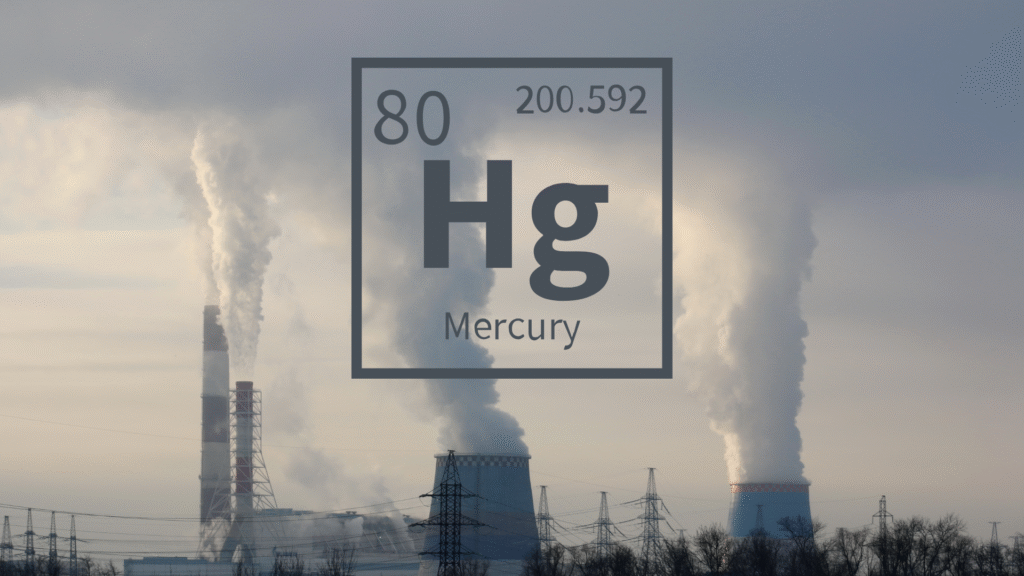
Mercury (Hg) is a silvery white metal distinguished by its unique status as the only metal that remains liquid at room temperature. The symbol “Hg” originates from the Latin term hydrargyrum, meaning “liquid silver,” reflecting its appearance. It occurs naturally both as a native element and predominantly as cinnabar (mercury sulfide, HgS), especially in regions with a history of volcanic activity. Mercury was once commonly used in thermometers, antiseptics, and various industrial processes, but its use has declined sharply due to its toxic effects and long-lasting impact on the environment. Environmental mercury poisoning events, such as those in Minamata Bay in Japan have highlighted the dangers of mercury exposure and led to stronger international regulations. Mercury is of critical concern to EPSE because our treatment process facilitates the precipitation of soluble mercury species from contaminated waste streams into chemically stable, insoluble solids, effectively reducing bioavailability and environmental dispersion.
Anthropogenic mercury emissions into aquatic ecosystems
Globally, direct releases of mercury to water are considered a major contributor to mercury contamination in freshwater systems, with an estimated 1,220 tonnes of mercury released annually to both water and land worldwide (UN Environment 2018). Given the global scope of this assessment, artisanal and small-scale gold mining, coal-fired power plants, waste incineration, the cement industry, and non-ferrous metal smelting are identified as the top five sources of mercury releases into aquatic environments (Global and regional trends, Streets et al., 2019). Asia accounted for approximately 45% of global anthropogenic mercury emissions in 2018, with China alone contributing 25.7%. In the European Union the energy sector with coal-fired power plants is a major source of mercury pollution, and the same pattern is observed in the United States (Johansson, 2021).
Mercury dispersion and health effects
Major industrial sources release elemental mercury (Hg0), which can be transformed into other forms. These include the unstable monovalent mercury (Hg+) and the more stable divalent mercury (Hg2+), which is the dominant form in soils and sediments. Microscopic organisms transform inorganic mercury into methylmercury (MeHg) through a process called methylation. This highly toxic compound builds up in living organisms and becomes more concentrated as it moves up the food chain. Methylmercury (MeHg) is the most common organic form of mercury in the environment and is mainly found in fish and shellfish, which are also the primary source of human exposure. One well-known example is the Minamata Bay environmental health disaster in Japan, where people suffered methylmercury (MeHg) poisoning after consuming fish and shellfish contaminated by wastewater discharges from the Chisso Co. Ltd. chemical plant (Sarker, 2021). Exposure to high levels of mercury can damage the brain, heart, kidneys, lungs, and immune system in individuals of all ages. Even low-level exposure to mercury can pose significant risks to human health, including:
- Disruption of the nervous system
- Impairment of brain function
- DNA and chromosomal damage
- Adverse reproductive outcomes, such as sperm damage, birth defects, and miscarriages
Risk management with the EPSE™ Method
Since mercury (Hg) cannot be degraded or broken down into harmless substances, the safe disposal of post-treatment sludge is of utmost importance. EPSE’s approach to mercury-containing wastewater treatment emphasizes both the efficient removal of Hg and the characterization of the resulting sludge. The EPSE™ process effectively removes mercury (Hg) from wastewater by forming a stable precipitate with very low re-solubility. This not only eliminates mercury from the water but also keeps it securely immobilized over time, ensuring long-term safe sludge disposal.
This article was written by

Solution Manager, M.Sc. (Tech) Env. Eng.
khawer.shafqat(a)epse.fi
References
UN Environment. Global Mercury Assessment 2018. United Nations Environment Programme, 2018. https://www.unep.org/resources/publication/global-mercury-assessment-2018
Streets, D. G., Horowitz, H. M., Lu, Z., Levin, L., Thackray, C. P., & Sunderland, E. M. (2019). Global and regional trends in mercury emissions and concentrations, 2010–2015. Atmospheric environment, 201, 417-427. https://doi.org/10.1016/j.atmosenv.2018.12.031
Johansson, S. (2021, December 16). Tackling mercury pollution of EU waters: Why coal combustion must end by 2027 at the latest. European Environmental Bureau. https://eeb.org/tackling-mercury-pollution-of-eu-waters-why-coal-combustion-must-end-by-2027-at-the-latest/
Sarker, A. (2021). Ecological perspectives on water, food, and health security linkages: the Minamata case in Japan. Environmental Science and Pollution Research, 28(25), 32177-32189. https://doi.org/10.1007/s11356-020-12210-1
